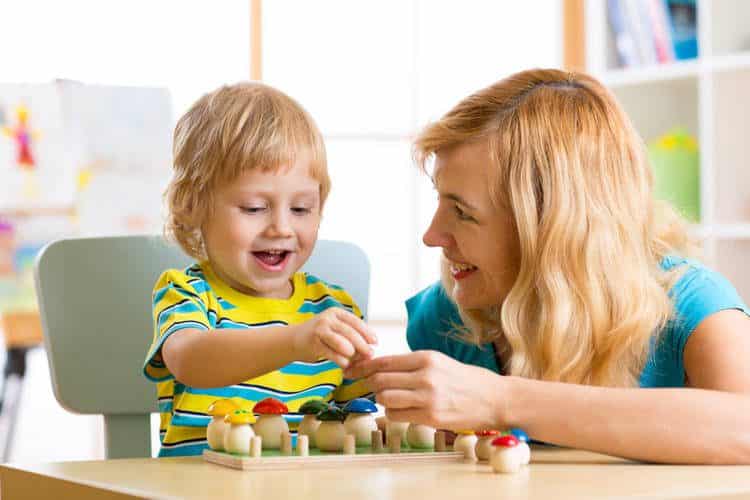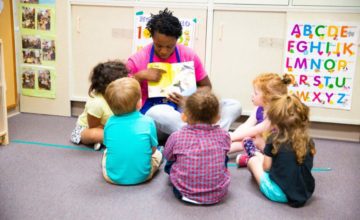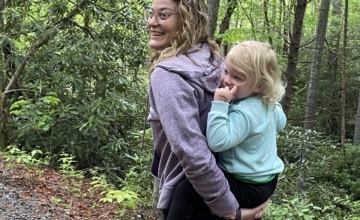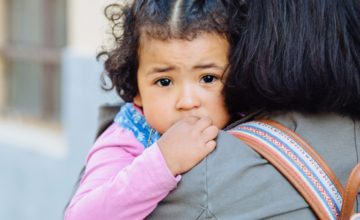The everyday conversations you have with your verbal and curious almost-3-year-old deepen the relationship between the two of you. Browse the information and links below to see what your little one is experiencing and learning this month.
What It’s Like for You
Esther was walking with her daughter, Miriam, age 34 months: When we got to the corner, Miriam poked her head out of her stroller, pointed to the sign and said, Mama, it says STOP! I almost fell over. I know she’s not ‘reading’ but it was amazing to me that she had figured out that those red signs and white letters had a meaning, and the meaning was to stop. It’s incredible how much she’s putting together on her own.
The everyday conversations you have with your verbal and curious almost-3-year-old deepen the relationship between the two of you. They also give you insight into what your little one is learning about and how she understands the world around her: Where do the clouds go? Is snow magic? These everyday moments offer many rich opportunities for introducing new ideas and concepts to your child. They also give you the chance to share your own beliefs and values: Look, that’s litter. Litter is when someone leaves their trash on the ground. Mommy is going to put it in the garbage can. That’s where trash belongs—not in our park. It’s these daily moments that help your child learn and also shape her life and world view in important ways.
What It’s Like for Your Child
Daddy took me to the dentist for the first time today. I didn’t like it one bit! First, I had to be quiet in the waiting room. I wanted to crawl under the table, but Daddy said, No! Then we went in to get my teeth cleaned. I had to sit in a big chair and it felt cold and slippery. Then the chair moved! It was a little scary. Then—the worst part! I had to lie back, and they put a scratchy bib on me. And they shined a big light on my face and the tooth cleaner leaned over me with something that looked like a silver fork. I pushed her hand away and started to cry and ripped off the bib and tried to get off the chair. I said, Daddy, I’m scared! I don’t like it! Daddy picked me up and cuddled me and helped me feel better. The hygienist showed me the tool she was holding—it wasn’t a fork after all, but a little mirror. She let me hold it and check her teeth! Together we counted how many teeth I saw in her mouth. She said that I should have 20 teeth. She asked me, Do you think 20 teeth is a lot or a little? I said, A lot. It’s because I’m big now! Then she asked me if she could look in my mouth. I said, Yes, and it wasn’t bad at all. When we were done, I got to choose a new toothbrush from her drawer. Of course, I picked green—my favorite color.
What Your Toddler Is Learning
Social-Emotional Skills:
- To rely on her father for comfort, safety, and reassurance when she is scared
- To recognize and name feelings, such as when she says, I’m scared
- To accept comfort and regain her composure by cuddling with her father
- To cope with and overcome fears, for example, by exploring the mirror to see that it’s nothing to be afraid of
Language and Thinking Skills:
- To use language to express feelings and needs
- To be curious—a key to learning—as she explores the hygienist’s mirror
- To use role-playing as a way to cope when she pretends to examine the hygienist’s teeth
- Early math skills when she counts how many teeth she sees in the hygienist’s mouth
- Logical thinking skills when she connects the idea that 20 teeth is a lot, and she has a lot of teeth because she is a big girl
What to Expect From Your Child’s Development
As you read the chart below, keep in mind that development is not a race and that every child grows at her own pace and in her own way. Your child may develop skills faster or slower than indicated below and still be on track. If you have questions or concerns, talk with your child’s health care provider or other trusted professional.
Your Child’s Development From 30 to 36 Months
| What Your Baby Can Do | What You Can Do to Connect With Your Baby |
|---|---|
My body lets me do “big kid” stuff now! |
|
I may be able to:
|
|
I use language to express my thoughts and feelings. |
|
|
|
I am using my new thinking skills to solve problems. |
|
|
|
I can do so many things by myself! |
|
|
|
I am starting to notice similarities and differences in people. |
|
|
|
My friends are very important to me. |
|
|
|
Did You Know…
That over the next few months your child is starting to grasp the very advanced concept of symbols? In one research study, children aged 2 ½ to 3 years old were shown a room and then taken to the lab and shown a scale model of the same room. Children then watched a researcher hide a miniature toy in the model room. They were then asked to go into the actual room and find the actual-sized toy in the same place as they saw the researcher hide it in the model. Children aged 34 months and younger did not successfully complete this task, even with instructions and demonstrations. They just didn’t grasp that the model was a symbol of the real room, or that the location of the miniature toy corresponded to an actual toy in the real room. However, children just a few months older, at 36 months, were successful at this game—showing they understood the relationship between a model and what it represents (the room). This is an example of early symbolic thinking skills.
What the Research Means for You
Your child is beginning to understand symbols—that one thing (like a block) can stand for another thing (a phone). This is an important skill for learning because it allows children to think about ideas and concepts, and to use their imaginations and be creative. It also leads to your toddler developing an understanding of how to use symbols. For example, when your child enters elementary school, she will be learning about symbols used in math such as the “+” sign. In reading, she will learn that the letters a-p-p-l-e make a word—a symbol for an actual piece of fruit.
To help your child develop symbolic thinking skills:
- Encourage pretend play. Imaginative play gives children many ways to use symbolic thinking skills—like using a cardboard box to be a racecar. Toys like building blocks and plastic interlocking blocks (which encourage children to construct and create) also develop symbolic thinking skills.
- Point to words as you read them. Point and read signs on the street. Show your child the menu before you order for her. Read books and run your fingers under the words as you speak them. Over time, your child will connect these letter symbols with words and ideas.
- Build on your child’s growing skills. At first your child may play “birthday party” with a plastic toy cake. As he grows, he will be able to create a cake out of a shoebox. It will not look anything like a “real” cake, but he will be able to imagine this box as a symbol for the real thing. You can help him by watching and participating in his play, and offering him the chance to use objects as “props” in new and more complex ways.
Spotlight on: Parenting a “Picky” Eater
Do you know a “picky eater”? “Picky” eating is when a child (or adult) refuses foods often or eats the same foods over and over. Picky eating usually peaks in the toddler and preschool years. Many parents worry that their picky eater is not getting enough nutrition to grow. But in most cases, he is. If you keep a food diary for a day by writing down everything your child eats., you’ll probably find that he is eating more than you thought.
Ellyn Satter, MS RD LCSW BCD, a researcher and practitioner in the field of pediatric feeding practices, explains that both parents and children have their own “jobs” to do when it comes to eating. Parents are responsible for providing healthy foods at meal- and snack-times. Children are responsible for what and how much they eat. This helps children learn what it feels like to be hungry and then full—and how to make healthy choices based on this awareness, for example eating when hungry and stopping when full.
The Role of Parents
Research has found that parents’ food preferences are linked to their children’s food preferences (Borah-Giddens & Falciglia, 1993). This is probably not a big surprise since we are more likely to prepare the foods that we enjoy, so our children are more familiar with that group of foods than others. Familiarity with foods is key, as a child may need to be exposed to new foods more than 10 times before he tries it.
What can you do to help your child enjoy a range of foods?
Eat a range of healthy foods yourself.
Make sure that your own choices are in line with the foods you want your child to eat and enjoy.
Prepare meals together.
Having a hand in making the meal increases the chances that your child will taste her “creation.” Have your little one assist with measuring, pouring, or stirring.
Avoid showing disgust or disinterest when trying new foods.
A study found that mothers who showed (with their facial expressions, body language or words) that they didn’t want to try a new food had children who also tended to refuse new foods (Carruth & Skinner, 2000). In short, your young child will probably be less willing to try something new if you haven’t tasted it. And if you are a “picky eater” yourself, then your child is likely to imitate you in this behavior, just as she imitates the way you talk on the phone or the way you wave good-bye to her each morning at child care.
What to Avoid
There are two big pitfalls to avoid when trying to nurture healthy eating habits in your child:
Forcing your child to eat.
The fact is that forcing children to eat usually leads to the child eating less. Forcing also teaches children to rely on others to tell them how much to eat and what they are feeling. This does not lead to healthy eating habits or good self-esteem. In fact, some research has shown that forcing children to eat can actually make picky eating behavior worse (Sanders, Patel, Le Grice, & Shepherd, 1993).
Nagging or making deals with your child.
“Just two more bites, just two more bites!” “If you eat your vegetables, you will get dessert.” Strategies like these tend not to work in the long run. Children who learn to make deals about eating quickly learn to make deals and ask for rewards for doing other things—like brushing teeth or getting their shoes on. And soon they won’t do anything unless there is a reward for it!
What About Dessert?
How do you handle your little one’s “cookie cravings” when they insist they are done with dinner (after 3 noodles) but still have room for something sweet? The following are some ideas for handling this common dilemma.
Serve a small treat with your child’s dinner (for example, one cookie or a small muffin).
Yes, he may eat it first or he may eat only the treat. But over time, your child will get hungry and eat the other, healthy foods as he learns that sweets are part of a meal, just not the only part. Soon, you might even find that he leaves the sweet on the side, opting to eat the healthier foods first.
Serve a small treat at the end of the meal regardless of how much your child has eaten.
Again, this teaches your child that sweets, when eaten in moderate servings, have their place. It also takes away the power of the dessert being a big, special reward that children are constantly pining away for. When you avoid negotiating “if you eat this, you get that,” you also eliminate a big power struggle. You may find that your child eats more of the healthy foods on his plate as a result.
Eliminate sweets altogether.
Some families believe that cookies, cakes, etc. are not appropriate for their family’s diet. Instead, try offering fresh fruit or cheese to end the meal.
If you are worried or have questions about your child’s growth or nutrition, it is a good idea to talk to your child’s health care provider. Keep in mind, however, that as long as your child is not losing weight and has the energy to play and interact, it is likely that he is eating enough to support his growth.
Let’s Play: Activities That Nurture Bonding and Learning
Float or Sink?
Fill a plastic bowl or bucket with water. Give your child a collection of interesting objects: a leaf, a cork, a spoon, a coin, a bar of soap, a small toy car. Ask your child to take a guess whether each item will sink or float when it is placed in the water. Games like this help your child develop logical thinking skills, observation skills, and encourage curiosity. As with any game involving water and small objects, put everything away and out of your child’s reach when you are done playing.
Macaroni Masterpieces
Show your child how to string yarn through tube pastas, like zitis. Let your child string pasta along a strand of yarn that, when tied, fits easily over her head. (When working on the stringing, it helps to tape one end of the yarn to the table so your child doesn’t lose the macaronis as she strings them.) If your child is interested, she can paint the macaroni “beads” and count them with you. Games like this develop early math skills, like one-to-one correspondence and counting, as well as fine motor skills (as she uses the muscles in her hands and fingers). Supervise your child while she plays with the necklace. Put it away, out of her reach, when you are done with this activity.
What’s on Your Mind?
1. I have a 10-year-old son and an almost 3-year-old daughter who has started repeating some of the phrases she hears her brother saying (like “butt” or “shut up”). I am not sure whether she knows what the words mean or not, but it is a little embarrassing when she says one of them in public. What can I do to help her (and her older brother) understand why some words aren’t okay to say?
This reminds me of the time I was driving with my 3-year-old daughter in one of Washington, DC’s notorious rush hour back-ups. All of a sudden, I hear from the backseat: “This damn traffic!” So sometimes it’s not just older siblings who slip up with their language…it can be grown-ups, too. (Guilty as charged!)
The first line of defense is prevention—helping your older child learn to watch what he says around your little one. Start by helping him see how important he is to your daughter. She wants to be just like him, so she spends a lot of time watching and imitating him, including how he talks. Explain to your son that this means he has an important job to do—modeling appropriate language for his sister.
Then sit down with your children and develop some “family rules” about words. Let them know it is okay to be angry or frustrated, but that it’s not okay to use hurtful or inappropriate, rude words like “shut up” or calling someone a “butt”. Then brainstorm with them words they can use to express themselves. The more they are part of the solution, the more likely it is that they will comply.
As for what to do when, despite all your efforts, your daughter calls her cousin a poopy-face? First, remember that children crave our attention. Even “negative” attention is rewarding. They are making decisions everyday about what to do (or not do) based on the feedback they get from us. And a big reaction tells them, “This worked great. I’ll have to try that one again!” The more matter of fact and unemotional your response, the less rewarding it is to your child, which means it is less likely she will use the inappropriate word again. So tell your daughter in a serious, calm voice: “It is not okay to call people names. It hurts your cousin’s feelings.” Then help her express herself in more acceptable ways. For example, you might say: “I hear how angry you are that Judith took your doll. Let’s ask her to return it so you can finish feeding her the bottle.” Make it clear that, while it’s okay to be angry, it’s not okay to use bad language.
Remember that 2-year-olds (and even 10-year-olds) are still learning about impulse control, so there are bound to be slip-ups occasionally. But with a calm and consistent response from you, they will learn to “get with the program” over time.
2. What should I do when my 2 ½-year-old won’t share her toys with our 8-month-old?
Sibling rivalry usually heats up once the younger child is crawling and getting into the older one’s stuff. I think about my own son’s shocked (and furious) face the first time his 6-month-old sister reached out and swatted his carefully-constructed block tower.
Rather than dreading these moments of conflict between your children, consider them opportunities to help them learn critical skills—in this case, conflict resolution. The first step is prevention. While it is important for both of your children to learn to share, it is reasonable that they have some toys they don’t have to let the other play with. This allows you to help them set some boundaries, which gives them a sense of control. You can help your toddler choose a few toys that are special to her that she can play with on her own (such as in her room or when her brother is sleeping.)
When a conflict happens, validate how your daughter is feeling: You get so mad when your brother wants to play with your toys. It’s hard to share. Then, help her empathize with her brother: He just wants to explore and play with you. He doesn’t mean to make you mad. Feeling understood and being able to put themselves in other’s shoes helps children move on to the next step—finding solutions.
Brainstorm with your older child ways to work it out with her younger sibling. The more she is involved in solving the problem, the more likely the solution is to work. For example, when your son reaches out and grabs the ball your daughter is bouncing, you can suggest that you and your daughter find another ball for him to play with. You can also help her think about ways her brother can participate. You might offer to read stories to your son while she builds her block tower. Then give him the job of being in charge of knocking it down, with your daughter’s permission, of course.
Also keep in mind that it is also important for your daughter to have some time to play on her own without worrying that her brother will “mess things up.”
Finally, look for ways your children can have fun together. You can give your baby maracas to shake while your daughter plays the xylophone. In the car, the two of them can play peek-a-boo or make funny faces at each other. It’s these loving, daily moments (including the very normal conflicts that happen and are resolved) that add up to a lifelong friendship.
Expert Reviewers
- Terrie Rose, PhD, President and Founder, Baby’s Space
- Ross Thompson, PhD, Professor of Psychology, University of California at Davis
- Robert Weigand, MS, IMH-E, Director, Child Development Laboratory, Arizona State University
This ZERO TO THREE newsletter series was made possible by generous funding from the MetLife Foundation.
*Additional reporting by Claire Lerner




